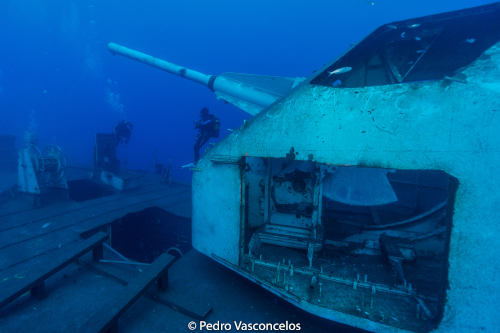Urban Diving from Lisbon, Portugal
Portugal won the World Travel Award - First European Destination in 2019.
So let's go to Portugal, starting with Lisbon.
1500€ per person
BOOK this amazing Adventure..!
Eight days/ seven nights in 3 or 4-star hotel or apartment, room for 2, bed and breakfast
Five days diving, ten dives
LISBON


Lisbon is the ideal place if you want to experience Portugal underwater. In the region, there are many places with many different characteristics.
The Cascais region has proved to be a good option. Its dive sites offer crystal clear waters north of Cabo da Roca and the incredible "Montanha de Camões" allow for great encounters.
Further south, after the 25 de Abril bridge, divers find Fonte da Telha and its distinctive dive sites such as Pedra da Lagoa, Pedra dos Safios, Malha, and the shipwreck of Maria Eduarda. The local dive center welcomes divers, assisted by the adjoining bar-terrace, allowing you to dive from this beautiful beach.
One of our favourite dives, depending on the sea conditions, is the wreck of Maria Eduarda, located a few kilometres from the coast. It is a wreck of a trawler about 60 years old, but still in a state of considerable conservation. It is possible to admire not only the structure of the ship but many species of resident fish. As in other areas of the region, around the Maria Eduarda you will find eels, fish, sea bream, anthias, velvet crab, and lobsters.
The region of Sesimbra, the "mecca" of diving on the continent, has countless protected dive sites, allowing dives all year, whatever the weather conditions. The dives not to be missed are the famous "River Gurara" in Cabo Espichel, the "Ponta da Passagem", "Pedra do Meio", "Pedra do Leão" and "Jardim das Gorgónias".
Info weather conditions
The weather is good all year long: summer is dry and warm, and winter is relatively mild. In January, temperatures approach 15°C and reach 35°C in August.
Water temperatures: 15 to 21°C Air temperatures: 11°C to 30°C
Our program offers two days of diving in Sesimbra, two days of diving in Cascais and one day of diving in Fonte da Telha. There will be ten great dives at ten different spots. We can change the schedule to accommodate one day or more, diving the Berlengas.
SESIMBRA

Sesimbra is a welcoming village, which was once almost exclusively a residence and place of work for fishers. The selected dive sites are in a protected marine reserve. You will find many species during your dives, guaranteed.
Garden of the Gorgonians is one of the most popular sites in the region, because of its easy orientation and diversity of life.
In the descent, sea breams will follow divers seeming to guide us to their territory. At the bottom, 15.5 meters in front of us is the main rock, we can see on the rocky ground soft corals and gorgonians. If you look closely, you will see fish that hide among the corals. This rock has several holes and cracks, each full of life: Forkbeard fish, octopus, moray, sponges, anemones, algae, and many starfish of different colours. Here we can also find a wide variety of nudibranchs.

CASCAIS

Cascais has always been the summer retreat of the Portuguese nobility. Today, the city is an elegant fusion of nineteenth-century decorative architecture and modern tourist facilities. Underwater, divers will surely have fun because they are quiet dives, full of life, and a seabed rich in flora and rock formations.
The Admiralty Bass is a vast rocky and sandy bottom characterized by the diversity of its topography, current, and visibility conditions. This dive site starts a few hundred meters from the coast, inside a small bay extending to the south. Inside the bay, at about 10 meters from the surface, pinnacle rock formations up to about 2 meters high emerge from the bottom of the sand. This area is bounded to the north, east, and west by a continuous sandy bottom.
As we move south, the east and west boundaries meet, and the rock formations give way to a 2-3m high wall that extends south to depths of 20m. In the rocky zone to the north, protected by the bay from the influence of currents, the visibility is normally greater than that which we can find further south. In some situations, it can vary from 5 to 10 meters in the north to less than one meter in the south.

Included 1500 € per person
- Eight days/ seven nights in 3 or 4-star hotel or apartment, room for 2, bed and breakfast
- Five days diving, ten dives
BOOK this amazing Adventure..!